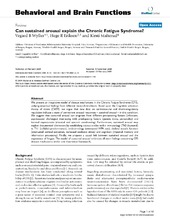| dc.contributor.author | Wyller, Vegard B. | |
| dc.contributor.author | Eriksen, Hege Randi | |
| dc.contributor.author | Malterud, Kirsti | |
| dc.date.accessioned | 2015-01-20T13:51:33Z | |
| dc.date.available | 2015-01-20T13:51:33Z | |
| dc.date.issued | 2009-02-23 | eng |
| dc.identifier.issn | 1744-9081 | |
| dc.identifier.uri | https://hdl.handle.net/1956/9221 | |
| dc.description.abstract | We present an integrative model of disease mechanisms in the Chronic Fatigue Syndrome (CFS), unifying empirical findings from different research traditions. Based upon the Cognitive activation theory of stress (CATS), we argue that new data on cardiovascular and thermoregulatory regulation indicate a state of permanent arousal responses – sustained arousal – in this condition. We suggest that sustained arousal can originate from different precipitating factors (infections, psychosocial challenges) interacting with predisposing factors (genetic traits, personality) and learned expectancies (classical and operant conditioning). Furthermore, sustained arousal may explain documented alterations by establishing vicious circles within immunology (Th2 (humoral) vs Th1 (cellular) predominance), endocrinology (attenuated HPA axis), skeletal muscle function (attenuated cortical activation, increased oxidative stress) and cognition (impaired memory and information processing). Finally, we propose a causal link between sustained arousal and the experience of fatigue. The model of sustained arousal embraces all main findings concerning CFS disease mechanisms within one theoretical framework. | en_US |
| dc.language.iso | eng | eng |
| dc.publisher | BioMed Central | eng |
| dc.rights | Attribution CC BY | eng |
| dc.rights.uri | http://creativecommons.org/licenses/by/2.0 | eng |
| dc.title | Can sustained arousal explain the Chronic Fatigue Syndrome? | eng |
| dc.type | Peer reviewed | |
| dc.type | Journal article | |
| dc.date.updated | 2013-08-28T16:57:51Z | |
| dc.description.version | publishedVersion | |
| dc.description.version | Peer Reviewed | |
| dc.rights.holder | Copyright 2009 Wyller et al; licensee BioMed Central Ltd. | |
| dc.rights.holder | Vegard B Wyller et al.; licensee BioMed Central Ltd. | eng |
| dc.source.articlenumber | 10 | |
| dc.identifier.doi | https://doi.org/10.1186/1744-9081-5-10 | |
| dc.identifier.cristin | 501025 | |
| dc.source.journal | Behavioral and Brain Functions | |
| dc.source.40 | 5 | |

